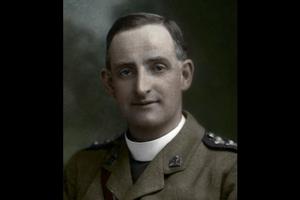A Personal Reflection on Father Willie Doyle
Father Doyle was mentioned in dispatches and recommended for Britain’s highest award for gallantry: the Victoria Cross.

Some 20 years ago, while doing research in a monastery library, I came across a passing reference to a priest and soldier. It intrigued me. His biography, published in 1920, was cited; I made a note, and left it at that, or so I thought. Because, unexpectedly, months later, I found the biography, and late one night sat down to read.
Like so many caught up in the conflict that came to be known as the Great War, Father Willie Doyle was buried where he fell, without marker or tombstone, just another casualty among millions. That should have been the end of matters; however, it proved not to be the case.
Before his death, he had requested that his private papers be burned. Thankfully, they weren’t; their subsequent discovery, and publication as part of the 1920 biography, caused consternation among those who knew him.
The papers revealed the intensity of the inner life he had led. Some were edified; others were horrified. His mortifications were deemed too harsh, his prayer life too extreme; but — and here was the thing — this was a man with a reputation unlike that of any gloomy ascetic. He was a much loved, affable priest, constantly joking around. This paradox only seemed to deepen the mystery surrounding Father Doyle.
Appearing at the start of the 20th century, he was a figure like Irish monks of old. After days spent leading retreats, hearing confessions, giving spiritual direction, and above all saying Holy Mass, at night another dimension of Father Doyle appeared. Hours were spent in long watches in front of the Blessed Sacrament, praying for the sanctity of priests, and were combined with frequent use of the Discipline, immersion in cold lakes, and nocturnal, barefoot pilgrimages in reparation. This may have all been hidden from view, but, importantly, was carried out with the knowing approval of Father Doyle’s spiritual director. Added to this was his less dramatic daily “war” on self; for instance, the “Butter Tragedy” — some days, he would have butter on his toast, others not, just one example of a constant spirit of mortification in everyday matters. And this, with his never-ending and countless spiritual aspirations, turned his waking hours into a litany of supplication to the merciful God.
Willie Doyle was born into a well-to-do, devoutly religious Catholic family on March 3, 1873. From this Christian home on the outskirts of Dublin, four of seven children entered some form of religious life. Having been educated in both Ireland and England, Willie entered the Society of Jesus.
After long years of study, he was ordained in 1907, and soon after was assigned to the Jesuit mission to parishes throughout the British Isles. From the start he excelled as preacher and confessor, and crowds flocked to him. Only after his death was the secret of such success revealed: penance.
When war broke out in 1914, Father Doyle volunteered immediately. In 1915, he landed in France. From then on, he marched every mile alongside ordinary soldiers — forgoing all privileges that his officer rank afforded him. This was his “flock,” and he was their “shepherd.” By the end, these battle-hardened soldiers would come to love their Padre. It was no surprise, as he suffered as much as they did. Through barbed wire, and in spite of bullets, shells and gas, he sought out his “sheep” as they lay dying, often alone in muddied battle fields, bringing Viaticum.
Father Doyle was mentioned in dispatches and recommended for Britain’s highest award for gallantry: the Victoria Cross. He was passed over, deemed to have a triple disqualification: Irish, Catholic and Jesuit. It was to make little difference. His eyes were on an altogether greater prize: the sanctity and the salvation of those placed in his care.
As if the dangers and privations of the front were not enough, throughout it all, Father Doyle continued with his own inner “war.” When possible, in those flooded, fetid trenches, the sounds of hell reverberating all around, the priest, with a pyx containing the Eucharist around his neck, spent hours on his knees adoring the Prince of Peace.
On Aug. 16, 1917, during the seemingly-never-ending Passchendaele offensive, Father Doyle was in the dreaded no-man’s-land, desperately trying to drag a wounded comrade back to safety. In so doing, he was blown to pieces by a German shell. Unlike the many to whom he had given a Christian burial, his remains were hastily interred in a makeshift communal grave, while all around the battle raged on.
For years, largely unknown in Ireland, at that desolate Flanders field the mortal remains of this forgotten hero awaited the only real recognition necessary.
With the news received this week — that he is declared a “Servant of God” and his cause opened — it seems that that recognition is at last to be granted Father Doyle.
- Keywords:
- father willie doyle
- american sainthood causes

















